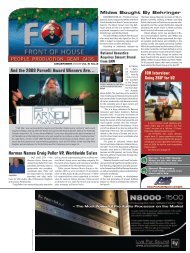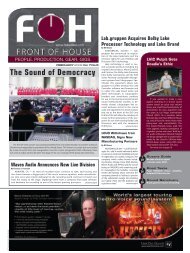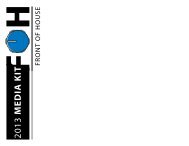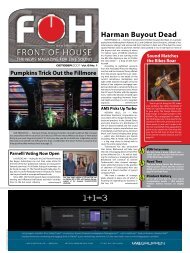Create successful ePaper yourself
Turn your PDF publications into a flip-book with our unique Google optimized e-Paper software.
36<br />
Road Test<br />
Yamaha IM8 Mixing Console<br />
Yamaha IM8<br />
I<br />
first had a look at the IM8 at the<br />
2008 winter NAMM show. John<br />
Schauer from Yamaha led me<br />
to the secret room where the not<br />
-yet-released board was waiting. Yamaha<br />
is not the only manufacturer<br />
that likes to keep their new products<br />
undercover until the moment of release.<br />
Just about every mixing console<br />
manufacturer conceals their new<br />
hardware until they are ready. What-<br />
ever the reasoning behind Yamaha's<br />
motives, John was definitely in secretagent<br />
mode at NAMM. He told me that<br />
this console was designed with houses<br />
of worship in mind. It has enough bells<br />
and whistles to satisfy a variety of mixing<br />
demands and is still very simple to<br />
operate. However, as I looked over the<br />
board, I thought it would work well in<br />
an array of operations outside of worship.<br />
I think this may be a good time<br />
to mention that this mixing console<br />
is built in the same factory as the PM<br />
boards. Just knowing this bit of information<br />
leads me to believe that<br />
this console is a well thought-out, designed<br />
and built console.<br />
The Gear RT<br />
All mono channels have both balanced<br />
XLR and TRS input jacks (Stereo<br />
channels have unbalanced stereo<br />
phone jacks and RCA jacks). You will<br />
also find one insert I/O and one direct<br />
out jack per mono channel. A +48-volt<br />
switch turns phantom power on and<br />
off at each mono channel followed by<br />
a 26-dB pad switch. The channel gain<br />
knob ranges from 60 dB to16 dB un-<br />
less the pad switch is engaged. In this<br />
case, the gain knob ranges from -34 dB<br />
to +10 dB. Stereo channel gain operates<br />
in the -34 dB to +10 dB range. The<br />
phase switch can come in handy and,<br />
of course, there is an 80-Hz high pass<br />
filter switch. Every mono channel also<br />
sports a one-knob compressor. Compression<br />
can incorporate a lot of complex<br />
parameters, but the Yamaha techs<br />
have squeezed them into one knob.<br />
The pre-amps are noticeably transparent<br />
and the EQ is smooth and accurate.<br />
These two characteristics<br />
of a console are enough to make or<br />
break it, and Yamaha knocked it out<br />
of the park for the price range.<br />
The four-band equalizer is next.<br />
Both mono and stereo channel high EQ<br />
and low EQ are fixed at 10 kHz and 100<br />
Hz. Mono channels have sweepable himid<br />
and low-mid, and stereo channels<br />
have their hi-mid fixed at 3 kHz and<br />
low-mid fixed at 800 Hz.<br />
All stereo and mono channels have<br />
eight individual aux sends. They are<br />
grouped in pairs for pre-fader and<br />
post-fader operations. The channel<br />
pan knob (mono) will get you into any<br />
of the eight groups or just send you<br />
left or right. The balance knob (stereo)<br />
adjusts the signal volume balance. The<br />
left input jack can be sent to the odd<br />
channel of the group or the left stereo<br />
bus and the right input jack can<br />
be sent to the even channels or right<br />
stereo bus.<br />
Input meters (mono and stereo) are<br />
made up of three LEDs and enable you<br />
to see if you are cruising along or slamming<br />
the channel input. Bus assign<br />
switches direct the signal to groups<br />
1/2 to 7/8 or the stereo or mono bus.<br />
You can mute your individual channel<br />
or assign it to the 1-4 master mutes to<br />
create up to four different mute configurations.<br />
This is a cool little feature.<br />
NOVEMBER 2008 www.fohonline.com<br />
Of course, smooth, long faders are on<br />
board for each channel. Besides where<br />
would we be without a pre-fader listening<br />
switch (PFL)?<br />
The master section is well thoughtout<br />
beginning with the four stereo aux<br />
returns. These returns can be sent to<br />
the eight group, stereo or mono bus via<br />
the bus assign switches. Each aux return<br />
has a level knob and a PFL switch.<br />
The aux sends are routed through<br />
eight faders with LEDs and AFL switches.<br />
Just right of the aux returns are<br />
2-track stereo/mono in/USB section.<br />
Here you can choose from RCA, USB<br />
and mini-plug inputs plus RCA, USB<br />
record outputs. The master group faders<br />
have on/off switches, LEDs, mono<br />
and stereo routing switches and AFL<br />
switches.<br />
The matrix section gives you four<br />
matrix outs fed from the groups, stereo<br />
and mono bus — very handy for<br />
those extra outputs. They also have<br />
rotary level control knobs and AFL<br />
switches. Next to the matrix section<br />
are the four mute master switches. The<br />
talkback section lets you route your<br />
talkback signal just about everywhere:<br />
auxes, groups, stereo/mono or through<br />
the matrix outs. Of course, you have a<br />
level knob and on/off switch. The master<br />
stereo out incorporates two faders<br />
PFL and AFL switches, an on/off switch<br />
and a stereo LED meter. There is also a<br />
separate mono master fader out. Not<br />
to be forgotten is the monitor section<br />
with its LED meters, PFL/AFL, monitor<br />
and phone level rotary knobs. One last<br />
note on the stereo and mono master<br />
outs: They both sport insert I/Os for<br />
throwing of a graphic EQ of whatever.<br />
The Gig RT<br />
My biggest gig with the IM8 was<br />
at a Billy Vera show. I was testing the<br />
32-channel chassis using 28 of those<br />
channels. The first thing that comes to<br />
mind is that the mixer is designed very<br />
logically. When I am using a new console,<br />
I don't want to think too much<br />
about the hardware — I want knobs,<br />
switches and faders to be where I expect<br />
them and important ones in obvious<br />
color displays. Yamaha did a good<br />
By JamieRio<br />
job with this mixer’s overall design.<br />
The pre-amps are noticeably transparent<br />
and the EQ is smooth and accurate.<br />
These two characteristics of a console<br />
are enough to make or break it, and<br />
Yamaha knocked it out of the park for<br />
the price range.<br />
I was uncertain about the oneknob<br />
compression, but it worked well<br />
and came in handy for things like bass<br />
and drums. Having the compression<br />
knob right there without having to<br />
patch anything in is sweet. I was mixing<br />
monitors from <strong>FOH</strong> at this gig and<br />
having a good amount of aux sends<br />
made things easier. Also, the faders<br />
on the aux sends made adjustments<br />
more accurate. I had two drummers<br />
at this gig, so the sub-groups were<br />
a must. In addition, both drummers<br />
did not always play at the same time,<br />
in which case master mutes came in<br />
handy.<br />
Also worth mentioning is that the<br />
mixer feels solid. That may be a hard<br />
concept to get across, but it is the difference<br />
between working with a pro<br />
piece of equipment and a toy. Billy<br />
has four horn players (two trumpets<br />
and two saxes), and once again, the<br />
onboard compression was invaluable<br />
with this section (not to mention the<br />
sub-groups). I think Yamaha will be<br />
able to fill a whole lot of mixing needs<br />
and scenarios (over and above worship<br />
sound) with this console, and at<br />
this price point, it is available to just<br />
about anyone who wants it.<br />
Yamaha IM8 Mixing Console<br />
What It Is: Analog mixing console.<br />
Pros: Logically designed, smooth<br />
and accurate EQ, affordable price.<br />
Cons: Nada.<br />
How Much: IM8-24: $4,799, IM8-32:<br />
$5,799 and IM8-40: $6,499.<br />
Web site: www.yamahaca.com
















